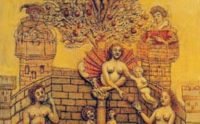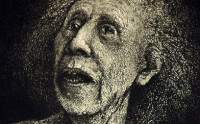Gregory Gillespie

At the young age of 41, Gregory Gillespie was the subject of a major retrospective at the Hirshhorn Museum at the Smithsonian, a museum that would eventually own 14 of his paintings. Moving against a prevailing artistic climate that championed the abstract, he became known for meticulously painted figurative paintings, landscapes, and self portraits, His work often had a fantastical element, infusing the mundane with a complex and often contradictory spirituality. As Gillespie’s oeuvre continued to develop, his style became more diverse and he experimented with varied media, incorporating objects and photographs into his paintings. He married Frances Gillespie in 1959, the pair connected over similar artistic techniques and inspirations, such as the work of Italian renaissance painters, and the pair traveled to Italy to study such artworks. Despite their artistic similarities, the pair divorced in 1983.
Gillespie studied at the American Academy in Rome on a Chester Dale Fellowship from 1964 to 1970. From there he moved to Amherst, MA, where he became the mentor to a group of talented young artists that eventually became celebrated throughout the country as the Valley Realists.
Gillespie’s work is in the permanent collections of the Metropolitan Museum of Art in New York, The Hirshhorn Museum and Sculpture Garden National Gallery of Art in Washington D. C., The National Museum of Art at the Smithsonian, The Whitney Museum of Art, and The Museum of Fine Arts in Boston to name just a few. See Frances Gillespie’s work here.
Learn More
Read The New York Times article, Gregory Gillespie, 64, an Unflinching Painter
Read The New York Times article, Finding the Reality That Lies Just Beyond the Real
Watch Robin Freedenfeld and Scott Prior discuss Gregory Gillespie’s painting technique
Watch Scott Prior discuss Gregory Gillespie

